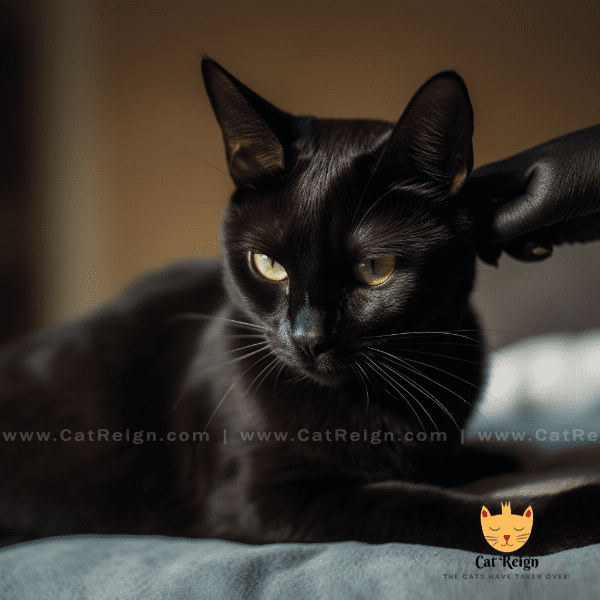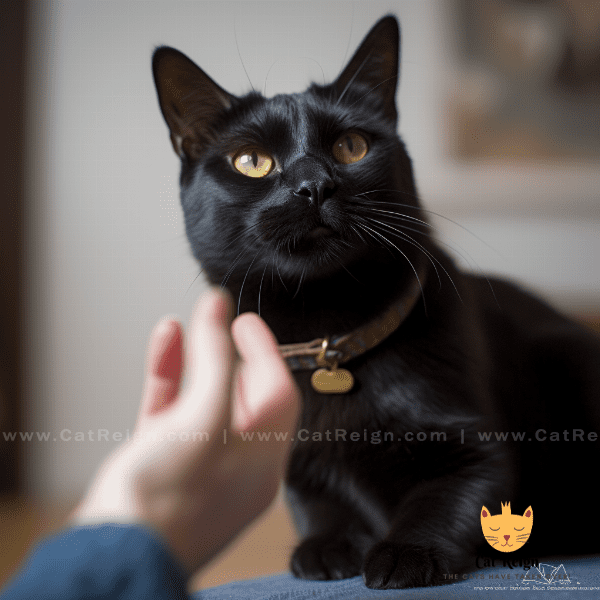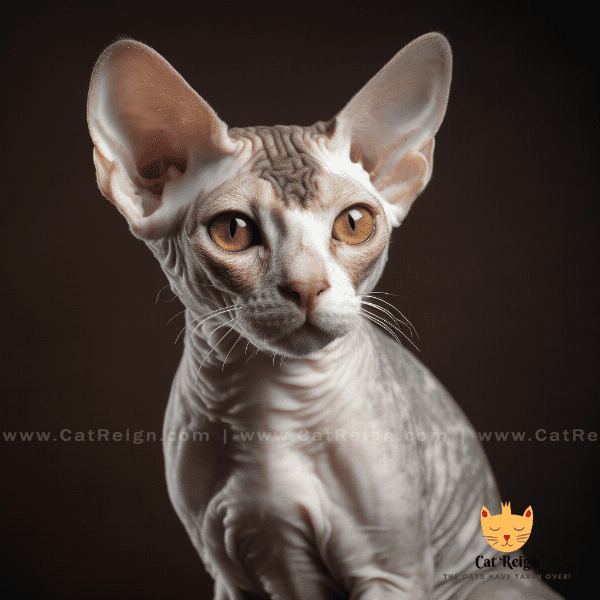Table of Contents
- Introduction to Bombay Cats
- Physical Characteristics of Bombay Cats
- Personality Traits of Bombay Cats
- Bombay Cat Care: Diet and Nutrition
- Grooming Your Bombay Cat
- Exercise and Playtime for Bombay Cats
- Common Health Issues in Bombay Cats
- Training Your Bombay Cat
- Socializing Your Bombay Cat
- Conclusion: Is a Bombay Cat Right for You?
Introduction to Bombay Cats
If you’re looking for a feline friend that is both affectionate and playful, then the Bombay Cat might just be the breed for you. This breed is named after the Indian city of Bombay (now known as Mumbai), and it is characterized by its sleek, black coat and striking golden eyes.
History of Bombay Cats
The Bombay Cat was first developed in the 1950s by a breeder named Nikki Horner. She aimed to create a cat breed that resembled a miniature panther, and achieved this by crossbreeding sable Burmese cats with black American Shorthairs.
Appearance of Bombay Cats
The Bombay Cat is a medium-sized breed that typically weighs between 6 to 11 pounds. They have a muscular build and a shiny, jet-black coat that is soft to the touch. The breed’s striking golden eyes are its most distinctive feature, and they give the cat an intense, expressive look.
Temperament of Bombay Cats
One of the most appealing things about the Bombay Cat is its affectionate and playful nature. They love to cuddle and will often follow their owners around the house seeking attention. These cats are also known for their intelligence and curiosity, and they enjoy interactive playtime with their owners.
About Bombay Cat as a Family Pet
While Bombay Cats do have a reputation for being affectionate, they may not be the best choice for households with very young children. Like any cat, they can become easily agitated if they are handled too roughly, so it’s important to teach children how to interact with them properly. Additionally, Bombay Cats are known to be vocal and may meow loudly if they feel neglected or bored.
In the next sections, we’ll explore the physical characteristics and personality traits of the Bombay Cat in more detail. We’ll also provide tips for caring for and training your new feline friend.

Physical Characteristics of Bombay Cats
Coat
The Bombay Cat’s coat is short, sleek, and jet black in color. It is also incredibly soft to the touch and has a glossy sheen that gives it a luxurious look. The coat is relatively easy to maintain, and regular brushing will help to keep it looking its best.
Body Type
The Bombay Cat has a muscular build that is medium-sized, typically weighing between 6 to 11 pounds. They have a broad, rounded head with large, expressive eyes that are a striking gold color. Their ears are rounded and set wide apart, and their tails are medium in length and taper to a fine point.
Eyes
One of the most distinctive features of the Bombay Cat is its eyes. They are large, round, and set wide apart, with a striking golden color that ranges from amber to copper. Their eyes are incredibly expressive, and they use them to communicate their moods and emotions.
Nose
The Bombay Cat has a short, broad nose with wide nostrils. It is usually black in color, which adds to the cat’s overall striking appearance.
Feet
The Bombay Cat has small, compact feet with black paw pads that match their coat color. They have sharp claws that they use for climbing, scratching, and playing.
Teeth
The Bombay Cat has a set of strong, healthy teeth that are essential for maintaining good overall health. It’s important to brush your cat’s teeth regularly to prevent dental problems from developing.
In the next section, we’ll explore the personality traits of the Bombay Cat in more detail.

Personality Traits of Bombay Cats
The Bombay Cat is a breed with a unique personality that sets it apart from other cats. In this section, we’ll explore the personality traits of the Bombay Cat in more detail.
Affectionate
One of the most notable personality traits of the Bombay Cat is their affectionate nature. They are incredibly loyal to their owners and enjoy cuddling up on laps for pets and snuggles. They will often follow their owners around the house seeking attention and will purr contentedly when they are being petted.
Playful
Bombay Cats are known for their playful nature and love to engage in interactive playtime with their owners. They have a high level of energy and enjoy playing with toys, chasing after strings, and climbing on furniture. Their playful nature makes them great companions for children and adults alike.
Intelligent
Another notable personality trait of the Bombay Cat is their intelligence. They are curious by nature and enjoy exploring their surroundings. They are also quick learners and can be trained to do tricks or respond to commands. Their intelligence makes them an engaging and interactive pet.
Independent
Despite their affectionate nature, Bombay Cats are also independent creatures. They enjoy spending time alone and are content to amuse themselves with toys or exploring their surroundings. They don’t require constant attention from their owners and can adapt well to a variety of living situations.
Vocal
Bombay Cats are known for their vocal nature and may meow loudly if they feel neglected or bored. They will often “talk” to their owners and use a variety of vocalizations to communicate their needs and wants. While their vocal nature can be endearing, it’s important to note that they may not be the best choice for households with noise-sensitive neighbors.
In the next section, we’ll explore the care requirements for Bombay Cats, including their diet and grooming needs.

Bombay Cat Care: Diet and Nutrition
Proper nutrition is essential for the health and well-being of any cat, including the Bombay Cat. In this section, we’ll explore the dietary needs of the Bombay Cat and provide tips for ensuring they receive the nutrition they need.
Choosing the Right Food
When it comes to feeding your Bombay Cat, it’s important to choose a high-quality, balanced cat food that meets their nutritional needs. Look for cat food that is made with high-quality protein sources, such as chicken, fish, or lamb, and that is free from fillers and artificial preservatives. You can also consider a raw or homemade diet, but it’s important to consult with your veterinarian before making any dietary changes.
Feeding Schedule
The feeding schedule for your Bombay Cat will depend on their age, weight, and activity level. As a general rule, adult cats should be fed two small meals per day, while kittens should be fed three to four small meals per day. It’s important to measure out your cat’s food to prevent overfeeding and obesity.
Hydration
In addition to a balanced diet, hydration is also essential for the health of your Bombay Cat. Always ensure that your cat has access to clean, fresh water at all times. You may also want to consider adding wet food or bone broth to their diet to help increase their water intake.
Dietary Restrictions
If your Bombay Cat has any dietary restrictions, it’s important to work with your veterinarian to develop a specialized diet plan that meets their needs. For example, some cats may require a low-fat diet to manage obesity or a low-protein diet to manage kidney disease.
Treats
Treats can be a great way to reward your Bombay Cat and provide them with additional nutrition. However, it’s important to limit the number of treats you give your cat and to choose high-quality, low-calorie treats. Overfeeding treats can lead to obesity and other health problems.

Grooming Your Bombay Cat
The Bombay Cat’s sleek, black coat is one of its most distinctive features, and proper grooming is essential for maintaining its health and appearance. In this section, we’ll explore the grooming needs of the Bombay Cat and provide tips for keeping their coat looking shiny and healthy.
Brushing
Regular brushing is essential for keeping your Bombay Cat’s coat looking its best. Use a soft-bristled brush or comb to remove any loose hair and tangles. Brushing your cat regularly can also help to prevent hairballs and reduce shedding.
Bathing
Bombay Cats do not require frequent baths, as their coats are naturally oily and water-resistant. However, if your cat becomes particularly dirty or greasy, you can give them a bath using a mild, cat-specific shampoo. It’s important to rinse your cat thoroughly to ensure that all the shampoo is removed.
Nail Care
Keeping your Bombay Cat’s nails trimmed is important for their health and well-being. Trim their nails regularly using a pair of cat-specific nail clippers to prevent them from becoming too long and causing discomfort or injury.
Dental Care
Dental care is also important for the health of your Bombay Cat. Brush their teeth regularly using a cat-specific toothbrush and toothpaste. You can also provide your cat with dental chews or toys to help keep their teeth clean.
Ear Care
Check your Bombay Cat’s ears regularly for signs of dirt, wax buildup, or infection. Use a cotton ball or pad moistened with a gentle ear cleaning solution to clean their ears. If you notice any signs of infection, such as redness, swelling, or discharge, contact your veterinarian.

Exercise and Playtime for Bombay Cats
Like all cats, the Bombay Cat needs regular exercise and playtime to stay healthy and happy. In this section, we’ll explore the exercise and playtime needs of the Bombay Cat and provide tips for keeping them physically and mentally stimulated.
Indoor vs. Outdoor Exercise
While Bombay Cats can be kept as indoor or outdoor pets, it’s generally safer to keep them indoors to protect them from cars, predators, and other hazards. However, indoor cats may not get as much exercise as outdoor cats, so it’s important to provide them with plenty of opportunities to move and play indoors.
Interactive Toys
Interactive toys are a great way to keep your Bombay Cat physically and mentally stimulated. Consider toys that encourage your cat to jump, climb, and chase, such as laser pointers, feather wands, or toy mice. Puzzle toys that require your cat to work for treats can also provide mental stimulation.
Scratching Posts
Scratching is a natural behavior for cats, and providing your Bombay Cat with a scratching post can help to satisfy this instinct. Choose a sturdy, tall scratching post that your cat can use to stretch and scratch. You may also want to consider providing multiple scratching posts throughout your home.
Playtime with Humans
Bombay Cats are social creatures and enjoy interacting with their owners. Set aside time each day to play with your cat using interactive toys or games. This will help to strengthen the bond between you and your cat and provide them with the physical and mental stimulation they need.
Exercise Equipment
If you have the space and budget, you may want to consider investing in exercise equipment for your Bombay Cat. Cat trees, climbing walls, and window perches can all provide opportunities for your cat to climb, jump, and play.

Common Health Issues in Bombay Cats
As with all Cat breeds, Bombay Cats are susceptible to certain health issues. In this section, we’ll explore the common health issues that can affect Bombay Cats and provide tips for recognizing the signs of illness and when to contact your veterinarian.
Obesity
Obesity is a common health issue in cats, including Bombay Cats. This can lead to a variety of health problems, including diabetes, arthritis, and heart disease. To prevent obesity, feed your cat a balanced diet, limit treats, and ensure that they get enough exercise.
Respiratory Infections
Respiratory infections, such as feline herpesvirus or calicivirus, are common in cats and can cause symptoms such as sneezing, coughing, and eye discharge. If you notice any of these symptoms in your Bombay Cat, contact your veterinarian.
Dental Disease
Dental disease is another common health issue in cats. Signs of dental disease include bad breath, swollen gums, and difficulty eating. To prevent dental problems, brush your cat’s teeth regularly and provide them with dental chews or toys.
Kidney Disease
Kidney disease is a common health issue in older cats, including Bombay Cats. Signs of kidney disease include increased thirst, decreased appetite, and weight loss. If you notice any of these symptoms in your cat, contact your veterinarian.
Heart Disease
Heart disease, such as hypertrophic cardiomyopathy, can also affect Bombay Cats. Signs of heart disease include difficulty breathing, lethargy, and coughing. If you notice any of these symptoms in your cat, contact your veterinarian.
Cancer
Like all cats, Bombay Cats can develop cancer. Signs of cancer include weight loss, lethargy, and abnormal lumps or bumps. If you notice any of these symptoms in your cat, contact your veterinarian.
It’s important to schedule regular check-ups with your veterinarian to ensure that your Bombay Cat stays healthy and happy. In the next section, we’ll explore the training needs of the Bombay Cat, including how to teach them basic commands and tricks.

Training Your Bombay Cat
While cats are often thought of as independent creatures, they can be trained to do a variety of tricks and behaviors. In this section, we’ll explore the training needs of the Bombay Cat and provide tips for teaching them basic commands and tricks.
Positive Reinforcement
The most effective way to train your Bombay Cat is through positive reinforcement. Use treats, praise, and affection to reward your cat for good behavior. Avoid punishment or negative reinforcement, as this can damage the bond between you and your cat.
Litter Box Training
Litter box training is an essential aspect of cat training. Show your Bombay Cat where the litter box is located and encourage them to use it. Keep the litter box clean and accessible at all times.
Teaching Basic Commands
While cats are not typically trained to obey commands like dogs, they can be taught to respond to certain cues. For example, you can train your Bombay Cat to come when called or to sit on command. Use treats and positive reinforcement to encourage good behavior.
Clicker Training
Clicker training is a popular method of training for cats. This involves using a clicker to mark the desired behavior, followed by a reward such as a treat. Clicker training can be used to teach a variety of behaviors, such as fetching or jumping through a hoop.
Teaching Tricks
Teaching your Bombay Cat tricks can be a fun and rewarding way to bond with them. Consider teaching your cat to shake hands, play dead, or give a high five. Use positive reinforcement and patience to teach your cat new tricks.
Training for Leash Walking
While Bombay Cats can be trained to walk on a leash, it’s important to start slow and be patient. Start by getting your cat used to wearing a harness or leash indoors before venturing outside. Always supervise your cat while on a leash and avoid busy roads or areas with other animals.
In conclusion, training your Bombay Cat can be a rewarding experience for both you and your pet. Use positive reinforcement and patience to teach your cat new behaviors and tricks.

Socializing Your Bombay Cat
Socialization is an important aspect of raising a healthy and happy Bombay Cat. In this section, we’ll explore the socialization needs of the Bombay Cat and provide tips for introducing them to new people and animals.
Early Socialization
Early socialization is crucial for Bombay Cats. Expose your kitten to a variety of people, animals, and environments from a young age to help them develop confidence and social skills.
Introducing to New People
When introducing your Bombay Cat to new people, it’s important to take things slow. Allow your cat to approach the person on their own terms and provide plenty of positive reinforcement, such as treats or affection.
Introducing to New Animals
Introducing your Bombay Cat to other animals can be more challenging. Start by introducing them to animals of a similar size and energy level. Always supervise your pets during introductions and be prepared to separate them if necessary.
Encouraging Playtime
Playtime is an important aspect of socialization for cats. Encourage your Bombay Cat to play with toys and engage in interactive play with you and other pets. This will help to strengthen the bond between your cat and other animals and people.
Training and Socialization Classes
Training and socialization classes can be a great way to help your Bombay Cat develop social skills and confidence. Look for classes specifically designed for cats or consider hiring a professional trainer to work with your cat.
In conclusion, socialization is an important aspect of raising a well-adjusted Bombay Cat. Expose your cat to a variety of people and animals, encourage playtime, and consider enrolling them in training and socialization classes.

Conclusion: Is a Bombay Cat Right for You?
After reading this comprehensive guide about Bombay Cats, you may be wondering if this breed is the right fit for you. In this final section, we’ll summarize the key characteristics and care needs of the Bombay Cat and provide tips for determining if this breed is a good match for your lifestyle.
Characteristics of the Bombay Cat
The Bombay Cat is a medium-sized breed known for its sleek, black coat and affectionate personality. They are intelligent, playful, and social creatures that thrive on human interaction. They are also generally healthy and have a lifespan of 12-16 years.
Care Needs of the Bombay Cat
The care needs of the Bombay Cat include regular grooming, a balanced diet, exercise and playtime, and routine vet check-ups. They also require early socialization and ongoing training to develop good behavior and social skills.
Is a Bombay Cat Right for You?
Before adopting a Bombay Cat, it’s important to consider your lifestyle and whether this breed is a good match for you. Do you have the time and resources to provide the care and attention a Bombay Cat requires? Are you willing to invest in training and socialization? If you’re looking for an affectionate, playful, and intelligent companion, the Bombay Cat may be the perfect fit for you.
In conclusion, the Bombay Cat is a unique and wonderful breed that makes a great companion for those who are willing to provide the care and attention they need. By understanding their characteristics and care needs, you can determine if a Bombay Cat is the right fit for you and your lifestyle.




